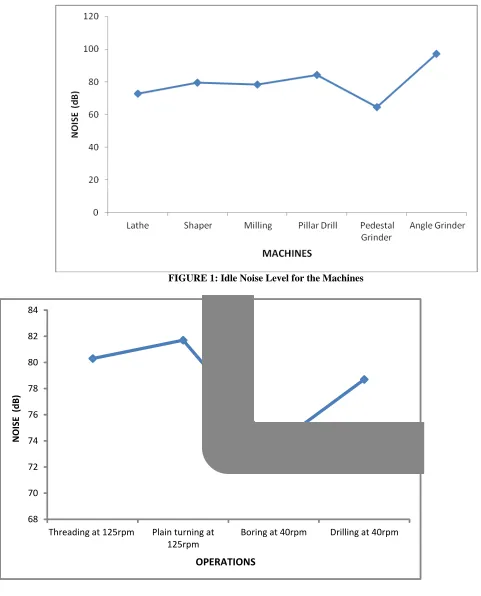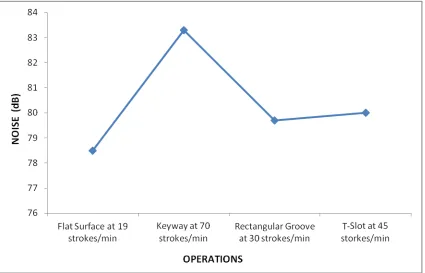Experimental Evaluation of Noise Emission by Work
Shop Machines Due To Production Activities
1
Amine, J.D.; 2Injor, O.M. and 3Ilonze, E.F.
1,2,3
Department of Mechanical Engineering, University of Agriculture, Makurdi, Nigeria.
DOI: 10.29322/IJSRP.8.12.2018.p8416
http://dx.doi.org/10.29322/IJSRP.8.12.2018.p8416
Abstract- Measurements of background, idle, and production noise generated during production activities of plain turning, drilling, boring, and threading on the Lathe; flat, keyway, rectangular grove, and Tee slot on Shaper; facing, plain milling, slot, gear, and threading on the Milling Machine; sheet metal, plat bar, angle iron drilling on the Pillar Drill machine; solid shaft, sheet metal, square pipe, angle iron, and stainless steel grinding on the Pedestal Grinder; and sheet metal, flat bar, square pipe, and angle iron grinding on the Angle Grinding Machine, were carried out at Engineering workshop of the Federal University of Agriculture Makurdi. Noise dosimeter and sound level meter with model 2310 SL and IEC 61672 type-2 factory calibrated with a resolution of 0.1dB were used. Measurements were taken one meter from the source of noise on each machine, and all the six (6) Machines were switched at the same time to determine the total noise generated. Results showed that the mean noise levels around these machines were lowest from the Lathe Machine which had 85.4dB, and highest for the Angle Grinder which had 107.8dB. This results serves as a standard for these machines when using noise as a diagnostic tool for preventive maintenance which showed that the machines were in good condition. Preventive maintenance at regular interval, are necessary to keep the machines in this condition.
Index Terms- Production noise, mean noise level, preventive maintenance.
I. INTRODUCTION
oise is sound that is not wanted by the perceiver, because it is unpleasant, loud, or interferes with hearing. Most machinery and manufacturing processes generate noise as an unwanted by-product of their output. Typical examples of noise sources in the workshop include; impact noise associated with punch processes, motors, generators and other electro-mechanical devices, unbalanced rotating shafts, gears, shaping machine, power saws, lathes, grinding machines, drilling machine etc (Anjorin et al, 2015).
Human production activities which require crushing, cutting, riveting, drilling, punching, pressing and drilling, results in the use of machines commonly found in the workshop to generate a lot of noise. The phenomena can transcend several human developments, ranging from breakdown of communication to annoyance and built-up tension. When several of these activities occur simultaneously the level of noise can go beyond being a nuisance, but harmful and inimical to the
production activity. Occupations at highest risk for Noise Induced Hearing Loss (NIHL) include those in manufacturing, construction, transportation, mining, agriculture and military (Ahmed et al, 2000).
High level noise not only hinders communication between workers, but depending on the level, quality and exposure duration of noise, it may also result in different type of physical, physiological and psychological effects on the workers (NIOSH, 1998). The acceptable noise exposure standard in the workplace is 85dB(A) averaged over an eight-hour period (Bies and Hansen, 1996; Schmidt 2005; Norton and Karczub, 2003). This is not to imply that below 85dB(A) a safe condition exist. It simply means that an eight-hour exposure of 85dB(A) is considered to represent an acceptable level of risk to hearing health in the workplace. Noise generated from the workshop causes health and social problems, it causes acute and chronic diseases such as cardiovascular dieses, acoustic trauma, noise induced hearing loss, hindrance communication between the employees, fatigue and loss of concentration. The noise induced hearing loss affects the both ears simultaneously. A person's overall noise exposure may come directly from an individual machine, but noise from other machinery or processes elsewhere in the workshop may also contribute to this.
A number of studies have been carried out to evaluate industrial noise in processing, mining, oil and gas, construction and manufacturing industries and the results show that high percentage of industrial workers were exposed to more than 85dB(A) noise levels (Ydego, 1991; Boateng and Amedofu, 2004; Kisku and Bhargava, 2006; Saadu, 1988; Bockhoff et al, 2003; Lim et al, 2008). In spite of these studies, high noise levels have been taken for granted in industries in developing countries especially Nigeria.
The environment has become heavily polluted by various human activities. Production activities also contribute to this pollution. Establishing the various sources of noise, and establishing measures of regulating same, will go a long way in ensuring that noise and its harmful effects are reduced to nearest minimum.
The aim of this study was to examine the effect of workshop noise as a result of production and operation activities of some machines on the health of workers.
II. MATERIALSANDMETHODS
Six machines namely, Lathe (Harrison 600), Shaping, (Elliott 14M), Milling (Ajax 28277), Pillar drill (Brook
Crompton MF5), Pedestal grinder (AJH Bison), and the Angle grinder (Bosch), were used in this study. At the beginning of the experiment, the background, idle, and production noise in various operations was carried out using the sound survey meter, sound level meter, and noise dosimeter respectively. The noise level for each operational duration of 60 seconds was recorded, and the average calculated using Equation 1.
) Where;
Ni - Idle noise Nm - machine noise
Nb - background noise
The overall noise was calculated using Equation 2 below. ) Where;
- Overall noise - Idle noise - Production noise
Three (3) speeds; low, medium and highest speeds were obtained directly from each machine used. The mean speed of the machine is obtained from Equation 3 below.
)
Production noise was obtained using Equations 4 Where;
- Production noise - Overall noise
- Background noise
Noise dosimeter and sound level meter with model 2310 SL and IEC 61672 type-2 factory calibrated with a resolution of 0.1dB were used. Measurements were taken one meter from the source of noise on each machine, and all the six (6) Machines were switched at the same time to determine the total noise generated. From the measurement of the noise, when the difference between the measured background noise level (that is when the machines are turned off), is equal to 10dB or more, the change in the resultant noise level after subtraction of the background noise level is negligible. But when less than 10dB, a correction is made to the noise level reading at a source to make the measured value valid using the addition and subtraction decibel scale. Measurements of sound level were done three times for each machine operation and the average reading was calculated and recorded in tables using Microsoft Excel spreadsheets.
III. RESULTSANDDISCUSSIONS
The result of idle noise levels, lathe operation noise, shaper operation noise, Milling machine operation noise, pillar drill
FIGURE 1: Idle Noise Level for the Machines
FIGURE 2: Lathe Operation Noise Levels
68 70 72 74 76 78 80 82 84
Threading at 125rpm Plain turning at
125rpm Boring at 40rpm Drilling at 40rpm
NO
ISE
(
dB
)
Figure 3: Shaper Operation Noise levels
FIGURE 5: Pillar Drill Operation Noise Levels
FIGURE 6: Pedestal Grinder Operation Noise Levels
80 82 84 86 88 90 92 94 96
10mm diameter
shaft 2mm thick sheet metal hollow square 1mm thick pipe
2mm thick angle
bar stainless steel0.5mm thick
NO
IS
E
(d
B)
OPERATIONS
78 80 82 84 86 88 90
25mm shaft 1mm sheet
metal 2mm sheet metal 20.6mm shaft 2mm angle bar metalic bar10mm wood
NO
IS
E
(d
B)
[image:5.612.96.518.343.633.2]FIGURE 7: Angle Grinder Operation Noise Levels
FIGURE 8: Operation and Idle Noise Levels of the Machines
0 50 100 150 200 250
NO
IS
E
(d
B)
OPERATIONS
Grinding Cutting
0 20 40 60 80 100 120
Lathe Shaper Milling
Machine Pillar Drill Pedestal Grinder GrinderAngle
NO
IS
E
(d
B)
MACHINES
FIGURE 9: Comparison of Different Categories of Machine Noise Levels
IV. CONCLUSION
From the results of the study, the machines in the Federal university of Agriculture Makurdi Engineering workshop are in good and safe working condition. The lathe produces lesser noise of 85.4dB compared to the angle grinder with 107.8dB despite its size which shows that the noise level of a machine does not correlate with its size.
However, there is high possibility of a chronic health hazard problem for workers working in the workshop where noise levels are greater than 85 dB. This is because after the workers are exposed to high noise levels, they come out from the noise source after their duty hours to an environment of lower noise level; in which there occurs both physiological change and psychological stress in their system (Anjorin et al, 2015).
Preventive maintenance should be carried out on the machines at regular intervals to maintain a good working condition, which will in turn greatly affect the noise emission levels during production activities. However, ear muffs should be used when operating the angle grinder.
ACKNOWLEDGEMENT
The authors extend sincere gratitude to all staff of the mechanical engineering department workshop of the university of Agriculture, Makurdi for cooperation in carrying out the research.
REFERENCES
[1] Ahmed, H.O., Dennis, J.H., Badran, A., Ismail, M., Ballal, S.G., Ashoor, A., and Jerwood, D. (2000). Noise exposure and hearing loss of workers in two plants in eastern Saudi Arabia. Annals of occupational hygiene. 58:371-380.
[2] Anjorin, S. A, Jemiluyi, A. O, and Akintayo T. C. (2015). Evaluation of industrial noise; A case study of two Nigerian industries, Europian Journal of Engineering and Technology, vol. 3, no. 6, pp.1-16.
[3] Bies, D., and Hansen, C. (1996), Engineering Noise Control, 4th ed., Taylor and Francis Publishing, New York
[4] Boateng, C.A., Amedofu, G.K. (2004). Industrial noise pollution and its effects on the capabilities of workers; A study from sawmills, printing presses and corn mills. African Journal of Health Science, 11; 1-2.
[5] Bockhoff, M., Mones, K., Timouchev, S., Ilhicov, K. and Aksenov, A., (2003), Numerical and Experimental Study of 3D Unsteady Flow in a Lawnmower for Prediction of Pressure Pulsation and Noise, 5th European Conference on Noise Control, Naples, Italy
[6] Kisku, G.C. and Bhargara, S.K. (2006). Assessment of noise level in a medium scale thermal plant. Indian journal of occupational, environment and medicine. 10:133-139
[7] Lim, C., Kim, J., Hong, J. and Lee, S., (2008). Effect of background noise levels on community annoyance from aircraft noise, Journal of the Acoustical Society of America, vol. 123, no. 2, pp. 766-71. [8] National Institute for Occupational Safety and Health NIOSH, (1998).
Criteria for recommended Standard: Occupational Noise Exposure, Revised
Criteria, Centers for Disease Control and prevention, Cincinnati, Ohio. [9] Norton, M. and Karczub, D. (2003). Fundamentals of Noise and
Vibration Analysis for Engineers, University Press, Cambridge, UK pp. 104. 0 20 40 60 80 100 120 NO IS E (d B)
MACHINE OPERATIONS
Shaper
[10] Saadu, A.A. (1988). Community and Occupational noise survey and analysis of some selected Nigeria cities and industries (Ph.d Thesis) University of Benin, Nigeria.
[11] Schmidt, C.W., (2005). Noise that Annoys: Regulating Unwanted Sound, Environmental Health Perspectives, vol. 113(1): A42-A44.
[12] Ydego, M. (1991). Assessment of noise pollution in Friendship Textile Mill Limited. Ubang, Dar es Salaam, Environmental Engineering 17; 479-485.
AUTHORS
First Author – Amine, J.D., PhD (Mechanical/Production Engineering), University of Agriculture, Makurdi. Nigeria. e-mail: jdpamine@gmail.com
Second Author – Injor, O.M., M.Eng (Metallurgical and materials Engineering), University of Agriculture, Makurdi. Nigeria. e-mail: injorman@yahoo.com
Third Author – Ilonze, E.F., B.Eng (Mechanical Engineering), University of Agriculture, Makurdi. Nigeria.
Correspondence Author – Amine, J.D., PhD
(Mechanical/Production Engineering), University of Agriculture, Makurdi. Nigeria. e-mail: jdpamine@gmail.com




